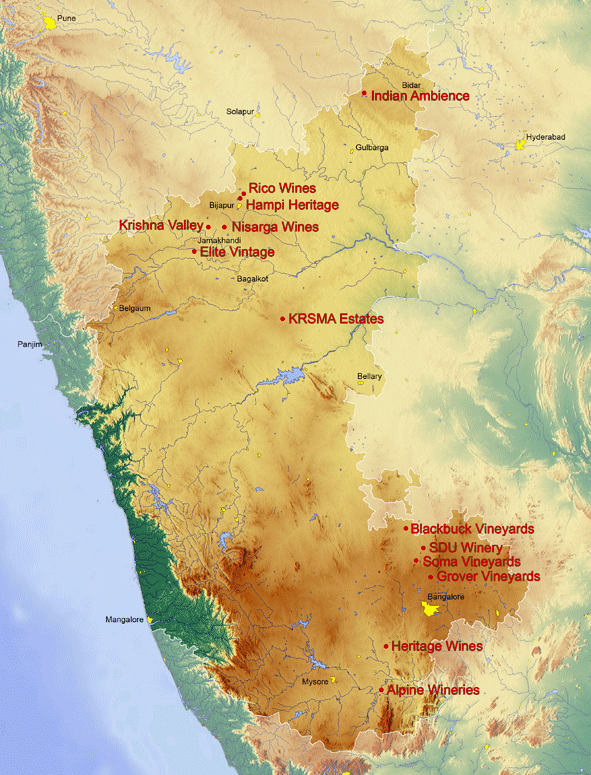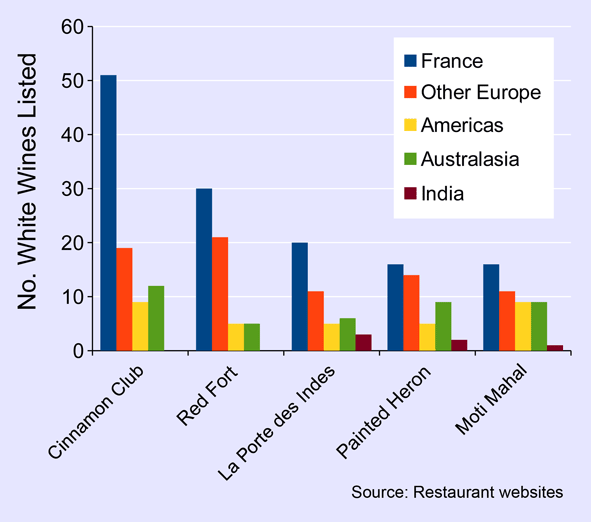Although pioneering Grover Vineyards was established in 1992, winemaking in Karnataka didn’t really take off until The Karnataka Wine Policy was introduced in 2007. This has encouraged entrepreneurs to invest, vineyards have been replanted with wine grapes and wineries have been established.
Significant sums are being invested into the Karnataka wine industry and we can already see some of the country’s best wines emerging from the state. Most of Karnataka’s important wineries are located on the topographic relief map below.
Karnataka’s wineries have been attracting a good deal of attention lately what with Grover Vineyards’ tie up with Vallée de Vin, KRSMA Estates winning critical acclaim for their wines, and the high profile launch of SDU Winery. Yet working quietly in the background, the Elite Vintage Winery looks as if it could well be one of the players shaping the future of wine in Karnataka.
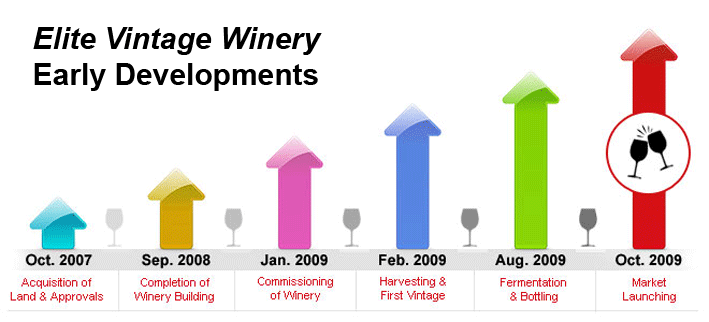 MD Vinod Guraddi and the other members of Elite’s management team have already proven themselves by meeting a series of tough deadlines in order to bring first wine to market in 2009. This was achieved in part by technical assistance from market-leader Sula Wines and it’s good to see different players sharing their knowledge and expertise. Ultimately the free exchange of such information can only be good for the industry as a whole as it seeks to raise standards and improve efficiency.
MD Vinod Guraddi and the other members of Elite’s management team have already proven themselves by meeting a series of tough deadlines in order to bring first wine to market in 2009. This was achieved in part by technical assistance from market-leader Sula Wines and it’s good to see different players sharing their knowledge and expertise. Ultimately the free exchange of such information can only be good for the industry as a whole as it seeks to raise standards and improve efficiency.
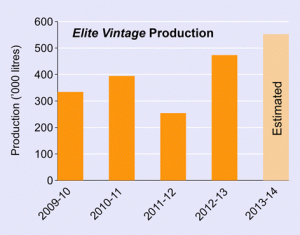 The initial winery capacity of 430 thousand litres was expanded to 730 thousand litres in 2011 and there are plans to add additional capacity next year. This has allowed the winery to ramp up production which it is hoped will break the 0.5 million litres mark in 2013-14.
The initial winery capacity of 430 thousand litres was expanded to 730 thousand litres in 2011 and there are plans to add additional capacity next year. This has allowed the winery to ramp up production which it is hoped will break the 0.5 million litres mark in 2013-14.
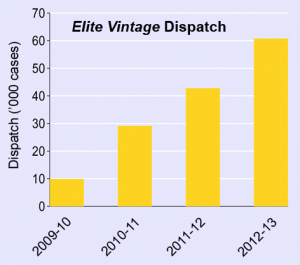 Elite’s wines are currently only available in Karnataka, but their marketing efforts have enabled them to record significant year-on-year increases in dispatch to market. Shipments to the Karnataka market totalled just over 60 thousand cases in 2012-13.
Elite’s wines are currently only available in Karnataka, but their marketing efforts have enabled them to record significant year-on-year increases in dispatch to market. Shipments to the Karnataka market totalled just over 60 thousand cases in 2012-13.
The excess that has occurred between production and dispatch to market has been considerably alieviated by the ongoing relationship with Sula Wines. Sula has shown great confidence in Elite by purchasing bulk wine from them which has then been utilised in Sula products sold in Karnataka.
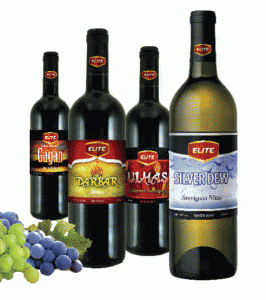 Wines marketed under the Elite label should soon become more widespread as they are already registered to retail in Andhra Praesh and have plans to register in Kerala, Tamil Nadu and Pondicherry. Prices have been fixed at a number of different price points in an attempt to attract a broad range of consumers. Current prices are Rs100, Rs160, Rs280, Rs380 and Rs480.
Wines marketed under the Elite label should soon become more widespread as they are already registered to retail in Andhra Praesh and have plans to register in Kerala, Tamil Nadu and Pondicherry. Prices have been fixed at a number of different price points in an attempt to attract a broad range of consumers. Current prices are Rs100, Rs160, Rs280, Rs380 and Rs480.
There are now a number of other wineries based in northern Karnataka (Nisarga, Hampi Heritage, Krishna Valley, Rico) as well as those based further south. With the domestic market not expanding as fast as some had predicted, and unsold wine remaining in tanks, it’s doubtful that a number of these will escape another industry shakeout.  Elite’s backers appear to recognise that success in the wine business is a long haul process and have confidently drawn up plans for a future winery. An attractive building coupled with visitor facilities would certainly be a welcome addition to the Krishna Valley wine region.
Elite’s backers appear to recognise that success in the wine business is a long haul process and have confidently drawn up plans for a future winery. An attractive building coupled with visitor facilities would certainly be a welcome addition to the Krishna Valley wine region.
There is still a majority view in the UK that the most suitable alcoholic drink to accompany Indian Food is beer. Lord Bilimoria dabbled with selling wines to partner Indian food, but he was not much more successful with this than with his efforts at importing polo sticks. Yet as the founder of Cobra Beer, he created a business whose products are seen and drunk in curry houses from Land’s End to John O’Groats.
This may be about to change, albeit slowly. As Brits increasingly consume more wine at the expense of beer, they are experimenting with food/wine combinations as never before. The old adage that “wine doesn’t match with spicy food” is on its way to the waste bin, aided by imaginative food and wine journalists and competitions such as What Food What Wine.
A number of the more expensive Indian restaurants in London carry extensive collections of wines, sourced from across the globe – see, for example, the Red Fort Wine List. Walk into any Italian restaurant in London and there is bound to be an extensive range of Italian wines on offer. In the same way, do Indian restaurants in London help to promote Indian wines?
In an attempt to anwer this question, I’ve tried to analyse the wine lists of five of the more pre-eminent Indian restaurants in London. Their selection is somewhat arbitary, but probably representative of the sector. The analysis looked at the origins of table wines available by the bottle (sparkling wines almost all hail from a particular part of France, that you may be able to guess!).
The situation for white wines is shown below. In all cases the single largest source of wines is from France, with the rest of Europe in second place. Wines from India occupy a tiny part of the listings, or none at all in the case of two of the restaurants.
The situation for red wines is little different. Most of the listings are given over to France and the rest of Europe, with Indian wines receiving a coverage which is little more than tokenism.
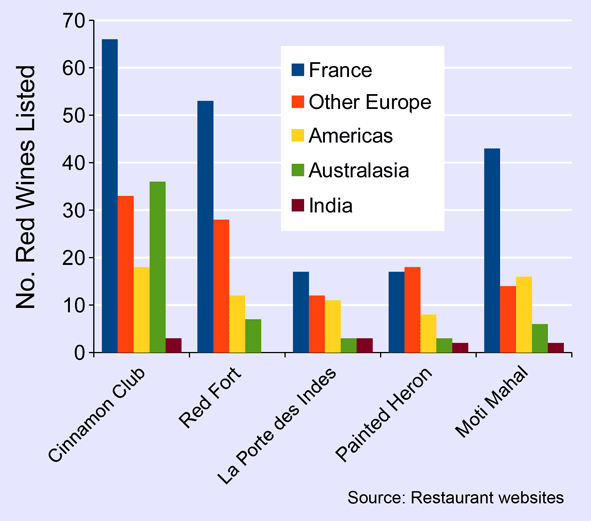
Considering the esteem with which top sommeliers are held these days, these listing seem tired, unimaginative and very conventional. India produces a number of aromatic white wines which are slightly off-dry and have fresh acidity. These can cut through thick sauces and really enhance food flavours. Hot (chilli) dishes may reject coarse tannins, but can often cope well with fruity reds with a smooth tannic structure.
So to sommeliers at London’s Indian restaurants I say: stop playing safe, encourage your clients to experiment, and list more Indian wines. To start you off here are four wines from four different producers that I’ve tried recently and that you could usefully list: Fratelli Chenin Blanc 2012; Vindiva Reserve Estate Sauvignon Blanc 2012; KRSMA Estates Cabernet Sauvignon 2012; Vallonne Vineyards Merlot Resrve 2011.
The best wine is, quite simply, the wine that you like the best. Since we all have preferences for particular books and breads, clothes and cuisines, films and foods it would be very surprising if there was universal agreement about the best examples and styles of wine. Surprising, and also very limiting, since one of the great joys of drinking wine at the moment is the sheer range of wine characteristics delivered to us by dedicated producers from different terroirs of the old and new worlds.
Nor is wine tasting an exact science, however much certain wine professionals or institutions might have us believe otherwise. We experience wine differently when alone or with friends; at home, at the winery or at a trade tasting; with food or without. These and many other environmental factors, sometimes including palate fatigue, inevitably influence our enjoyment and assessment of a particular wine.
In a world where new wines appear on a daily basis, there is a role for wine critics to attempt to make some sense of the plethora of choices with which the consumer is now confronted. Our language and vocabulary for describing how we experience tastes and aromas is highly limited, in much the same way that words cannot adequately convey the beauty of a fine artwork or a perfectly executed cover drive. So in producing a tasting note the wine critic is reduced to using analogies. Flavours and aromas might be described as being similar to those of particular fruits, or tannic structures might be compared to particular materials. It’s all too tempting to wax lyrical as to the feelings a wine might evoke: a Nashik Cabernet with the power of Chris Gayle, perhaps?
Wine tasting notes are not for everyone and may even put off some consumers. What does seem to be sought after, not least evidenced by the queries received at IndianWines.info, are wine scores. So over the next few months tasting notes and scores for wines from a number of producers’ wines will be uploaded. Scores are based on a 100 point scale described in more detail here. Do bear in mind that these scores are in part subjective; no right or wrong numerical values can be assigned to a glass of wine.

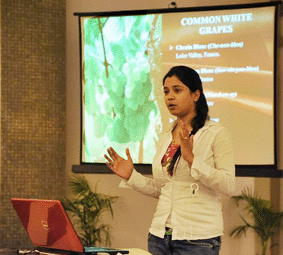 Notwithstanding the difficulties that it has faced over the past few years, the Indian wine industry continues to grow and diversify. Most of that growth has come about because increasingly sophisticated Indian consumers have developed an appreciation of the social pleasures of sharing a glass of wine and are very willling to try local products. Consumers are also showing a keen interest in developing their wine knowledge and palates which has inevitably lead to the creation of a number of wine clubs and societies.
Notwithstanding the difficulties that it has faced over the past few years, the Indian wine industry continues to grow and diversify. Most of that growth has come about because increasingly sophisticated Indian consumers have developed an appreciation of the social pleasures of sharing a glass of wine and are very willling to try local products. Consumers are also showing a keen interest in developing their wine knowledge and palates which has inevitably lead to the creation of a number of wine clubs and societies.
The oldest of these is the Delhi Wine Club, founded in 2002, which recently celebrated its 200th event. Congratulations! Meanwhile the Mumbai-based Wine Society of India, with its distinguished foreign advisers, can lay claim to being India’s largest wine club. Wine clubs have also been established in a number of other metropolitan areas including Bangalore, Chennai, Kolkata and Nashik.
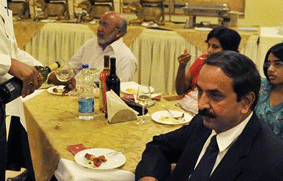 Now the Orange city of Nagpur has joined the trend with the first wine club in central India. The first ever seminar on wine in Nagpur was conducted in late 2010 and following the enthusiasm shown there, the Nagpur Wine Lovers Club (NWLC) was established in Janury 2011 with 11 initial persons. Form these small beginnings, and in less than two years. the NWLC now has 112 registered members. Organised events have seen lectures and tastings from prominent Indian wineries including Sula, Nine Hills, Four Seasons,Turning Point, Chateau D’ori, Ambrosia and Pause.
Now the Orange city of Nagpur has joined the trend with the first wine club in central India. The first ever seminar on wine in Nagpur was conducted in late 2010 and following the enthusiasm shown there, the Nagpur Wine Lovers Club (NWLC) was established in Janury 2011 with 11 initial persons. Form these small beginnings, and in less than two years. the NWLC now has 112 registered members. Organised events have seen lectures and tastings from prominent Indian wineries including Sula, Nine Hills, Four Seasons,Turning Point, Chateau D’ori, Ambrosia and Pause.
NWLC’s activities have included wine courses and one day workshops for Wine retailers, cafes, restaurants and Bars. Future plans include Nagpur’s – and central India’s – first ever Wine & Food Festival. NWLC has recently obtained membership of the Indian Grape Processing Board who, together with the All India Wine Manufacturers Association, have agreed to help sponsor a Wine Festival scheduled on 2nd & 3rd March 2013.
Further details of the NWLC can be found at nagpurwineloversclub.com
